After visiting Romania, George Cusworth reflects on the challenges facing Romania's subsistence peasant farmers, whose traditional agricultural practices support rich, biodiverse landscapes but who are increasingly under threat from financial pressures and external interests.
All photographs curtesy of Alexander Turner.
About the author: Dr George Cusworth is a postdoctoral researcher at the University of Oxford. He works on the Livestock, Environment and People (LEAP) project, funded by the Wellcome Trust. He wrote this blog after visiting Romania in May 2022.
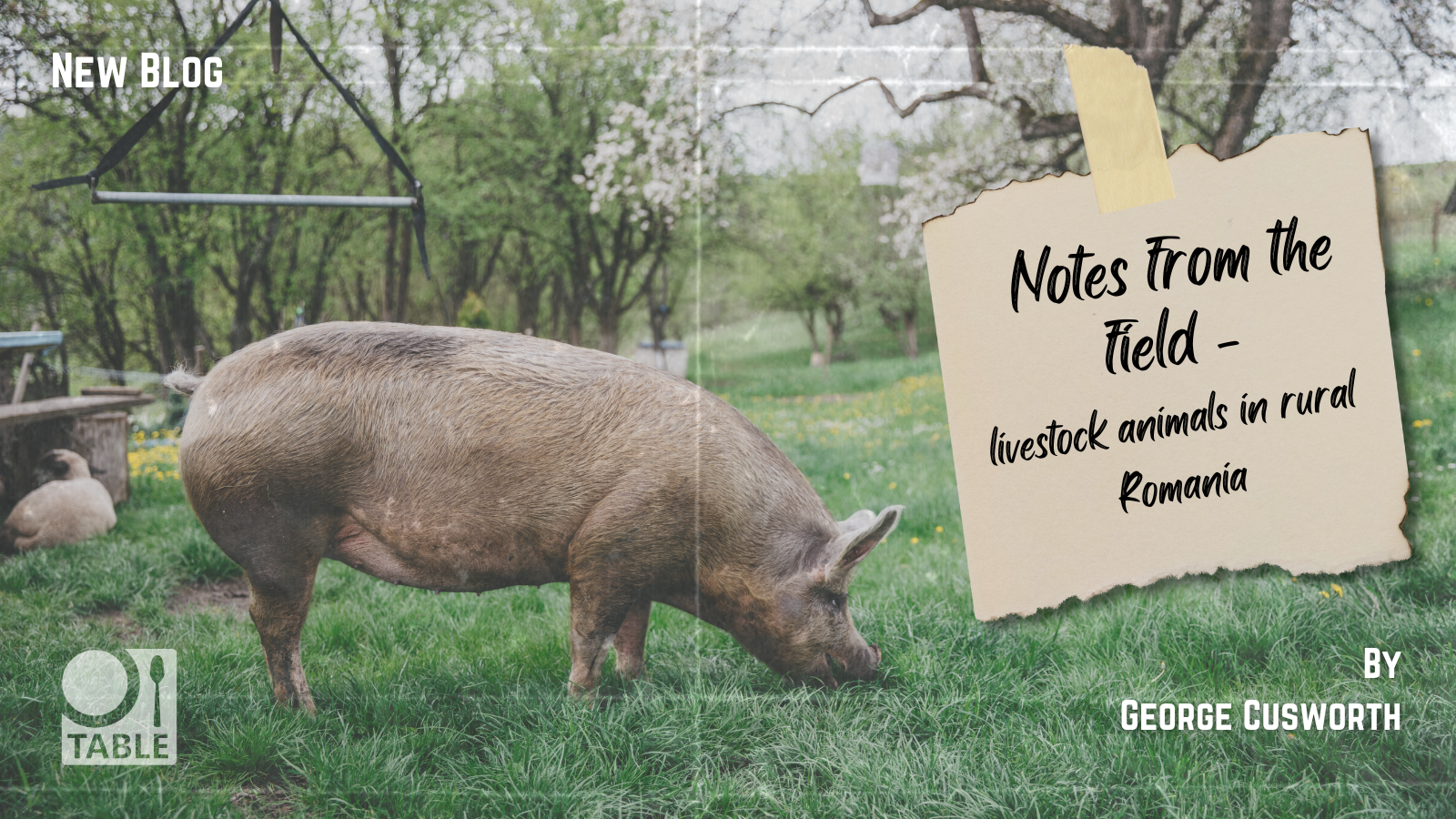
Romania contains some of Europe’s last true wilderness. The country is home to 60% of Europe’s brown bear population, and 10% of its wolves. The Carpathian Mountains have become the venue for one of the continent’s largest and most ambitious sites for rewilding and species reintroduction. It possesses, at the same time, some of the Europe’s last vestiges of subsistence peasant farming. Shepherds graze small flocks of sheep and cattle on rich and biodiverse open meadowland. Small plots of land are strip farmed by individual households, creating a mosaic of arable cropping, horticulture, grazing and fallow land. Back gardens bristle with plum and apple trees and vegetable plots, whilst chickens and pigs are fed on household food waste.
This unique land use and food system has been shaped by its history of Soviet rule, agricultural collectivisation and, more recently, the country’s accession into the European Union. Under the Soviet regime, agriculture was managed under state enterprises and agricultural co-operatives. Like many across the Eastern bloc, people grew their own food to insulate themselves from the vagaries of Soviet food provisioning. Romania’s economic growth was limited in the after-war period, with much of the wealth produced through its natural resources and industrial activities siphoned off to Moscow. After the fall of the Soviet Union in 1989, and after the country’s brief period of civil unrest, Romania’s economy and infrastructure emerged as a country decades behind its European neighbours. Its limited exposure to the programme of international development and globalisation had, though, preserved in situ a snapshot of rural Europe’s peasant farming past: traditional subsistence farming communities, ox-drawn ploughs, horse-drawn carts, great swathes of collectively grazed meadows, bounded by vast wildernesses and patrolled by apex predators.
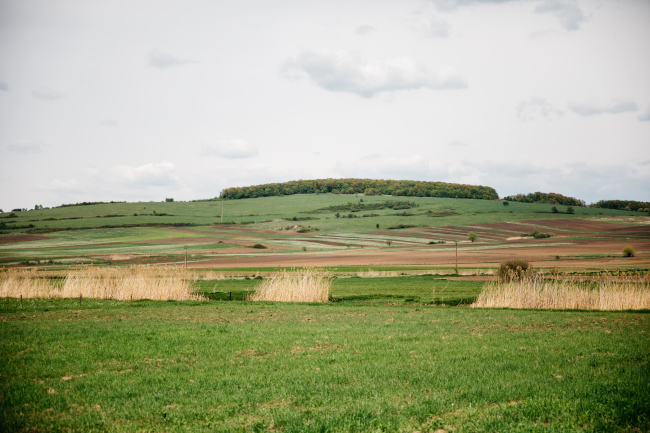
A Romanian agricultural mosaic landscape with green fields and trees on a far hilltop. Photo by Alexander Turner.
A changing landscape
Whilst the country’s accession into the EU in 2007 saw the introduction of new measures designed to protect cultural heritage and wildlife, it also opened the floodgates to external investors looking to capitalise on the country’s untapped agricultural potential. As new agricultural systems are inserted into the landscape in the form of intensive arable rotations of wheat and oilseed rape, as ancient meadows are ploughed up and reseeded with highly productive grass mixes, and as the rural population migrates to the cities and to other European countries, there are also groups looking to push back against these trends and carve out space for traditional and small-scale farm systems. The future of the Romanian countryside is uncertain, and various futures are argued for and on offer – ones that are characterised by commodity production, land ownership concentration, and agricultural intensification; others by the preservation and resurgence of its extant traditional farming systems and the protection of the environmental assets those systems have helped create. With the emergence of new rewilding initiatives looking to use large areas of the Romanian countryside for species reintroductions and conservation, these food systems tensions are being complicated further still.
More from TABLE on rewilding
Several groups of actors, with more or less coherent agendas for the future of the country’s countryside, can be sketched out. There are supporters of small-scale traditional farming practices looking to protect the traditional livelihoods that have preserved the country’s natural capital and cultural heritage. Local charities like Fundatia, along with international organisations like La Via Campesina fall under this bracket. There are the small-scale subsistence farmers themselves. This is a very mixed group. Some are passionate about the preservation of the farm systems they employ whilst others are looking to remove themselves and their families from the hardships of peasant farming practices to pursue economic opportunity elsewhere. There are large rewilding organisations, like Conservation Carpathia Foundation and the World Wide Fund for Nature (WWF), who are excited about the country’s conservation potential. These groups have large international financial backers, and they largely prioritise biodiversity over food system objectives. There are financial organisations who are looking to countries like Romania for the investment potential manifest in undeveloped yet fertile agricultural land – potential that has grown with the influx of European subsidisation schemes. There is, finally, a growing urban middle class anxious about climate change and biodiversity loss who is increasingly interested in the way Romania’s countryside might contribute to a sustainable food system.
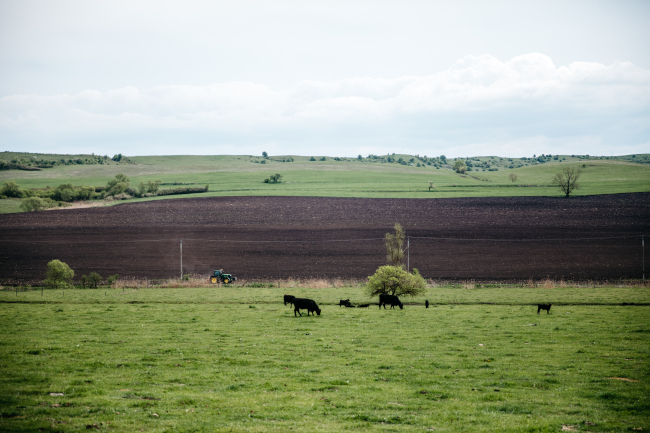
A Romanian agricultural landscape with traditional meadows in the background, recently ploughed land in the midground, and angus beef cattle grazing on reseeded grass mix in the foreground. Photo by Alexander Turner.
These competing visions are written into different attitudes towards the role that livestock animals should play in the food system. As the country’s urban population grapples with injunctions to eat less meat and dairy, and as vegan restaurants pop up in Bratislava, Cluj-Napoca and other major cities, Romania has become a melting pot for contestations about the role of livestock in a future agriculture.
So what’s the beef?
Across the world, widespread scrutiny is being placed on the role of animals in sustainable food systems. Except for the animals raised purely on grass and other locally grown forage and fodder, livestock feed is driving deforestation and biodiversity loss across the tropics. When these land use changes are paired with the direct emissions produced by the animals themselves (particularly by ruminants like cattle and sheep), there is acute anxiety about the warming impacts of livestock farming. These concerns are being exacerbated by the correlations between meat consumption and health problems like heart disease, and cancer. With these environmental and health concerns meshing with a much longer history of animal welfare activism, the last few years has seen the discussions around the need to reduce intake of meat and dairy filter into the mainstream.
There has, more recently, been push back from advocates of less intensive livestock systems, who want to see a little more nuance in the discussion. It is not the animals per se that are bad, they argue, but rather the industrialised model into which they have been placed. The blame, instead, needs to be directed to the economic model that has sought to intensify, mechanise, and globalise the food system, distance consumers from producers and their locality, and normalise excessively high levels of meat consumption. If humans and their agricultural systems managed to live within the earth’s planetary boundaries for so long, so this argument goes, then perhaps inspiration needs to be sought from more traditional ways of producing food. Particularly when it comes to the question of livestock, meat and dairy, many claim that such farm systems can provide a model for a more healthy, nutritious, environmentally sustainable and fair food system. With Romania’s rural future at a fork in the road, there is good reason to want to survey just what these practices are, and to explore how and if livestock animals fit in.
Silvo-pasture
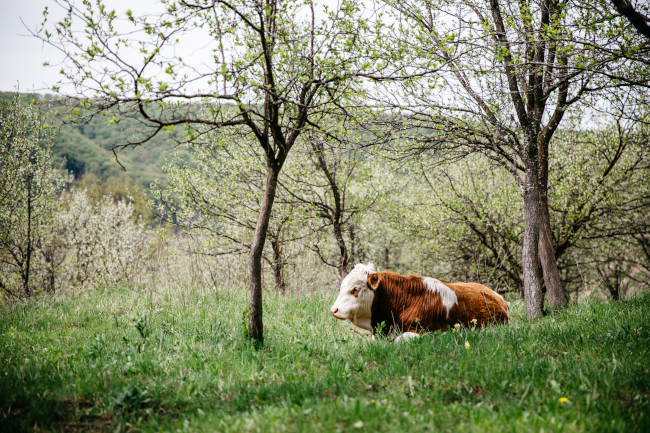
A cow lays in the shade of several budding fruit trees in a traditional Romanian agroforestry system. Photo by Alexander Turner.
Many traditional farms practice silvo-pasture, a practice in which livestock animals graze in and amongst trees. The related agroforestry term relates to the combination of trees and arable or horticultural production. In Romania, where there is a long history of plum and apple production management brought in with the medieval influx of Saxon people, many houses have small orchards in their back gardens where chickens and pigs are allowed to roam. Where orchards do exist on larger scales, farmers graze flocks of sheep and cattle, or rent the grazing out to local shepherds. The introduction of animals into the orchards – traditionally done on the first of May - was an important moment in Romania’s agricultural calendar. It’s worth noting that the co-location of animals in fruit and nut orchards is by no means limited to Romanian farming. Silvo-pastoral systems across Europe, Central and Southern America, Africa and Asia contain different combinations of goats, sheep, chickens, pigs and cattle with nut trees, fruit trees, trees for timber and berry bushes.
Beyond just the cultural heritage manifest in these silvo-pastoral systems, scientific research is also beginning to reveal the environmental benefits of these systems. The combination of trees and livestock animals can improve soil health, create diverse food outputs from the same land, and lock up carbon in the soils and trees. These claims are increasingly being used by advocates of traditional, low-intensity food production systems to show how their practices can help meet biodiversity and warming mitigation targets. Such arguments are often couched in systems-thinking terms. By pushing back against the land management practices and ecological simplification at the heart of intensive agricultural systems, this diversification can create more robust and complex ecologies that are less dependent on synthetic inputs such as pesticides and fertilisers. For these reasons, advocates of regenerative agriculture and agroecology have sought to work out how silvo-pasture systems can be folded into modern farm business management.
Meadows and pasture
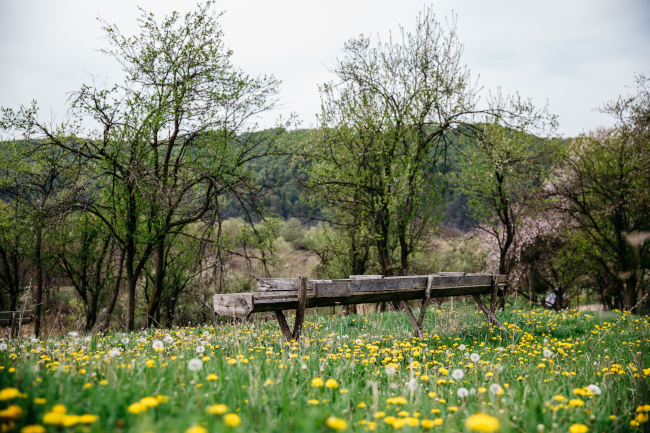
An old cow trough in a Romanian agricultural meadow. Photo by Alexander Turner.
Traditional pastoral farming has helped create expanses of biodiverse and ecologically rich grass meadows. With much of Romania’s countryside insulated from the agricultural intensification and pesticide application regimes of the Green Revolution, the country’s grasslands are areas of significant biodiversity and carbon storage value. Particularly because of their vegetative diversity, and the mass and variety of insects they contain, Romania’s meadows have received protections from the EU’s Natura 2000 project.
Although the health of these ecosystems can be undermined through overgrazing, many in the alternative farming space consider livestock animals to be central to their longevity and ecological health. The presence of browsing and grazing animals creates diversity in the structure of the grass and soil. Their manure helps cycle nutrients between different soil heights and creates food for insects and worms. More generally, megafauna like cattle are framed as a keystone piece in ecologically functional grassland ecosystems – surrogates for now missing wild animals like bison, and the now extinct aurochs. Although such claims are hotly contested, some see the high carbon content of healthy soils as reason to be optimistic about the offsetting potential of well managed healthy grassland. The regenerative agricultural movement is leading this particular charge - attempting to reframe ruminant animals as allies and ecosystem engineers that are necessary to unlock the soil’s climate mitigation potential.
Circular food systems
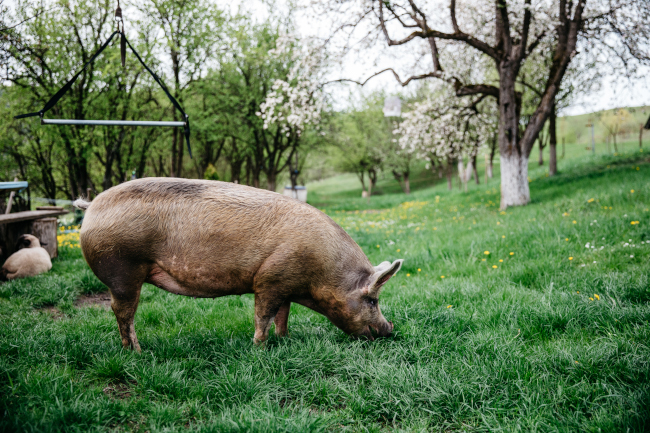
A pig grazes in a silvo-pasture system in Romania. Photo by Alexander Turner.
Under the Soviet regime, each household was allowed to keep a small quota of livestock animals outside of the collectivisation regime, and so they became a key part of people’s self-sustenance efforts. The animals - particularly monogastrics like pigs and chickens – were (and remain) prized by locals for their ability to cycle nutrients around the house and farm and to turn food waste into nutritious food. For these reasons, many argue that livestock animals are crucial to our ability to maximise the food system’s agricultural potential, helping turn waste products and marginal land into sources of food for humans.
Whilst bigger actors have made efforts to apply these principles of circularity – the UK supermarket Tesco, for example, redirects its unsold food into the pig feed used by its suppliers– some see the harmonious dynamics between different crop types, land uses, and livestock animals as being feasible only at a smaller scale. Advocates of regenerative and agroecological methods are trialling multispecies grazing systems to work out how the circular food systems that are hard at work in the backyards of rural Romania, can be used in the management of the farm.
Under threat?
Although these practices can yield positive outcomes with regards to biodiversity, carbon sequestration and cultural heritage, there are major questions about the role that low-input low-output farm management styles should play in the food system. If the country’s farm sector reverted back to the farm practices described above, it is questionable if they would be able to sustain the diets of Romania’s current population, particularly if consumption rates of meat and dairy continue to grow. In spite of these uncertainties, there may still be good reason to look to these traditional practices for insight into how livestock animals might fit into a sustainable food system. The future of such farming practices, however, remains uncertain even in places like Romania. Many believe that large scale rewilding projects are central to efforts to navigate the interlinking species extinction and climate change crises. The Carpathians have become a focal point for these ambitions, with three organisations - Romanian state’s environment agency, Conservation Carpathia Foundation, and the WWF – all acquiring land and working with local landowners to realise their rewilding plans. These projects, however, can create conflicts and compete for land use with local agricultural and community interests and with more land being managed under their jurisdiction, Romania’s traditional farm systems have been thrust to the fore of the tensions between large-scale conservation projects and incumbent farming livelihoods.
Primarily interested in the restitution of functionally intact ecosystems through the reintroduction of animals like the European bison, wolves and the subsequent minimisation of human intervention, these projects have sought to exclude the presence of shepherds who have historically used the Carpathian’s high meadows for their summer grazing, and the foragers who come to the forests in early autumn for mushrooms and berries. Many rewilding projects rely on large-scale land acquisition and so areas that have been used by local people on an informal basis are now fenced off and subject to surveillance and management. Although the environmental ambitions that inform these rewilding projects may be commendable, they often come at the expense of the viability of livelihoods of the people who have long used those areas for food, resources and leisure. While many locals are enthusiastic about the influx of investment and tourism these projects can bring, some have expressed concern over the limited involvement that local landowners, shepherds and forest dwellers have had in project design, and the dwindling access they now have to the ecosystems they once relied on.
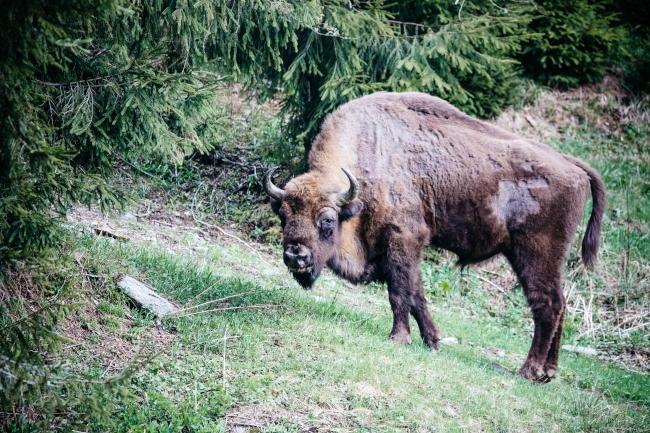
A bison stands in a forest in Romania. Photo by Alexander Turner.
Alongside these rewilding projects, there are other forces impinging on the viability of traditional peasant farming systems. Since the country’s accession into the EU in 2007 and its participation in Europe’s common market, its agricultural subsidy programme, the price of land in Romania has skyrocketed. Not least because of the country’s high and largely untapped agricultural potential, many investment firms that focus on agricultural land assets have moved in. Investigative journalists have documented the underhand methods that have been used to prise land from local ownership, including forged documentation, forced sales, corrupt officials, and intimidation.
The influx of foreign investment that has entered into the countryside in more or less lawful ways is having a dramatic impact on Romania’s rural land ownership structure and the viability of traditional agricultural systems. New managers typically want to bring their newly acquired lands into line with a more intensive, productive and modern agricultural management style. Although schemes like Natura 2000 offer some protection, there are great areas of biodiverse and ecologically complex meadows that are being ploughed up and reseeded with either productive rye grasses or for arable cropping rotations of wheat, barley and oilseed rape. Many traditional pastoralists who have used the land around where they live as if it were commonly owned, find grazing meadows and access tracks that they have used for decades fenced off. Romanian land ownership systems are particularly opaque thanks to the land redistribution that followed the dissolution of the Soviet regime, and so many do not know the extent to which their rights or lands have been infringed upon. The new infrastructures these ownership changes have precipitated are also changing the movement of Romania’s wildlife. The wolves, bears and lynxes that have benefited from the country’s largely unfenced rural landscapes are now being funnelled towards villages, creating new interactions and hostilities with their inhabitants.
It is, of course, too easy to frame these emerging intensive agricultural systems and rewilding schemes as those being foisted onto an unwilling and resistant local population by foreign actors. The truth is, of course, much more complicated. Like many marginal agricultural areas across Europe and around the world, people are moving to the cities in pursuit of economic opportunity and to remove themselves from the toil of subsistence farming livelihoods. The land being sold on to rewilders and international agri-businesses is, in many instances, being done enthusiastically, whilst the transition towards modern intensive agricultural management is seen as the only economically viable way of working the land. Nevertheless, with the twin forces of agricultural development and rural depopulation taking hold in Romania, many of the traditional agricultural practices that might provide a template for a more sustainable food system are being squeezed out of the country.
Post a new comment »
As for the HNV grasslands created by mowing and grazing, they're not economically viable now. Nothing non-intensive really is viable economically now, except for the niche eco-organic products, so they're being abandoned and the places are being abandoned and depopulated. Romanians want a lot of meat and, just like at the global level, there's zero chance of meeting that demand with this less damaging system. If you look up the events of the end of the 1980s and start of the 1990s you may see mentions of how important eating meat is, unfortunately. We have some serious inferiority complex going on.
The situation is similar in many ways to the herders in the Amazon, and there is deforestation going on which helps to create new grasslands, they go together (herders prevent natural reforestation). In terms of carbon, the article discounts enteric emissions from ruminants and the eutrophication effects on the ecosystems, including and especially high-biodiversity grasslands which are usually oligotrophic.
Don't assume all of Romania's semi-natural grasslands are that great, it's not that common. Those rare semi-natural grasslands with high biodiversity are fragile, intensification as well as abandonment results in their end. There are efforts to replace grazing with management that maintains biodiversity, even by using mowing, and sometimes by encouraging locals to gather plants that can be sold, usually for export, or by encouraging tourism.
There's no real balance here, the people in these areas are condemned to poverty and also condemned to ruin biodiversity if they try to live a rich lifestyle and promote land development, including roads and other infrastructure. The article is suggesting some type of indigeneity, and perhaps that's valid, but modernization ends it... while it's cruel to keep those people in poverty in some type of living museum.
The article misses the macroeconomic point overall. These highland economies are not isolationist. Sure, traditionally they wear a lot of animal-based clothes and build wood houses, but that's not the economy. The traditional economy is commodified, it requires trading the products. For the herders, that's selling cheese, skins, wool (fresh milk is not traditionally traded since it's fresh). For the more forest-oriented, they sell lumber and various forest products. For the "backyard pig" ones, it has become more common to consume the pig as subsistence, usually to make meat products for the winter holidays; but in the past even those pigs were or meat products were sold at the markets. You can recognize this problem with the sheep herding sector, because Romanians simply don't like sheep meat, and aren't too much into sheep cheese. The sheep herders are constantly complaining about this, so they export the sheep, usually on live transports to the Middle East, during the summer heat. It's not traditional to consume so much sheep; in fact, so overgrazing is the default, and you can see that in the erosion effects.
Both of these economies, pastoralist and silvical, rely on exporting to the "lowlanders", especially in cities, from which they get money to buy nice clothes, grains, tools, supplies, and send (some) children to school. Those economies ended. They ended earlier with the industrialization of agriculture and praticulture, and they ended in 1989 when the subsidized logistical and processing systems started to decay, ending those distribution chains (ex. the milk collection system ended, the slaughterhouse systems ended, thus leaving small animal farmers without a place to offload their product easily) - and this got much worse after joining the EU and applying EU standards. My point is that they were not really sustainable in the autonomous sense, it was a simply a lower intensity land-use limited by a hard life (look up their childhood mortality rates). And please don't only focus on the rich minorities (land owners), that's not who I'm talking about.
To put it simply, the pre-industrial society and culture is dying out, and it can't be saved as a case, only systemic and cultural changes can help. And it's on a timer, since cultural transmission isn't happening much and the old are dying while the young, who've been away, don't know the old ways. The man-made biodiversity is going to be lost either way, and climate heating will probably accelerate that.






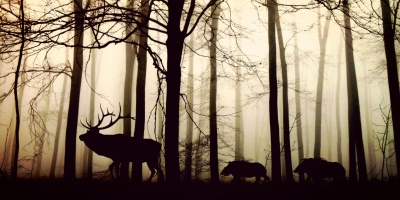
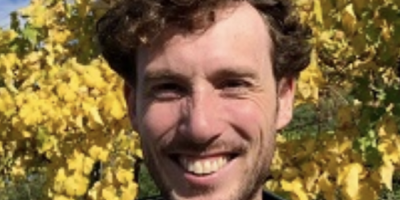


ecological and ethical farming